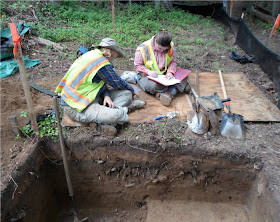Back in the field today, watching my crew find more wonderful things. Above, drawing the profile of a 1x2-meter block. You can clearly see the road fill, which is the dark stuff on top, with the lighter natural soil below. (In this location all of the natural topsoil was graded away before they put down fill.) And you can see a darker zone directly in front of Lucas's legs that may be a pit feature, although it is a lot clearer in this photo than it was in person this morning.
Taking notes and sorting artifacts. In the profile of this block you can see the mixed fill on top, then the dark bank of the natural plowzone, and below that layers of sandy soil containing lots of artifacts.
Some goodies. Above, a small pile of potsherds that I think are Accokeek, 1000 to 700 BCE, a small point that is probably Halifax, 4000 to 3000 BCE, an unfinished point and a scraper. Below, two more points photographed yesterday, another Halifax or maybe Clagett on the bottom and Lamoka or Normanskill on top, ca. 2500 BCE.
Below, a nice view of the site from the next point up the creek. The best part of the site is at the end of that point you see, but that part isn't threatened, so we are digging along the shore of the cove.






those old points are really cool. artifacts such as those make me long for a time machine (but a safety net, too).
ReplyDelete